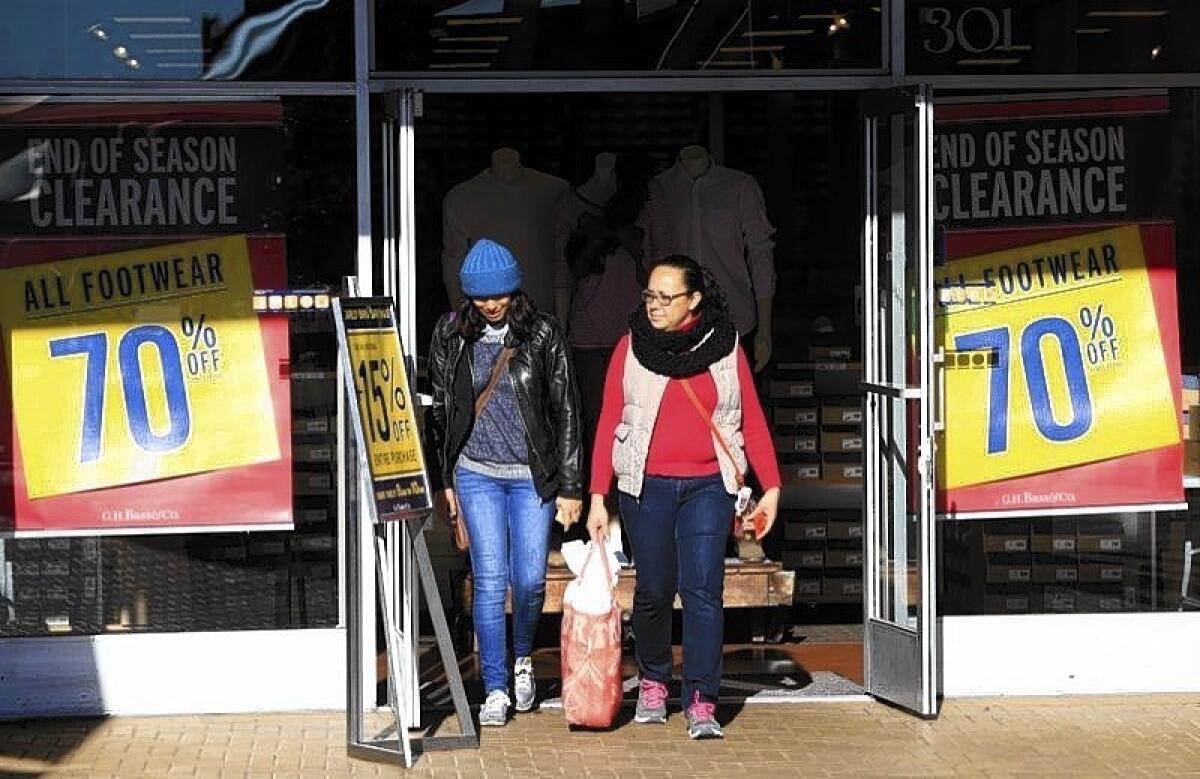Holiday season sales rise but foot traffic slides

Santa slacked off during the holidays, delivering a solidly so-so season for retailers.
Shoppers were less impressed and more careful during the season compared with the previous one, doing their research before picking through shelves of uninspiring and often deeply discounted merchandise, according to a flurry of data, estimates and analyst notes released this week.
Consumers spent $265.9 billion at stores during November and December, causing sales to rise 2.7% from a year earlier, according to initial results from data firm ShopperTrak. That’s slower than the 3% growth rate seen the previous year.
Black Friday led the rest of the season in revenue and traffic, even though the day’s proceeds sank 13% from the prior year as longer opening hours on Thanksgiving sucked away sales.
Christmas week, which ended Dec. 28, was the busiest even though most stores were closed Christmas Day. The week, which included four of the season’s top 10 busiest days, garnered 15.5% of all holiday revenue and 16% of visits.
But as sales rose for the holidays, foot traffic slid 14.6%, ShopperTrak said.
The shorter season, with just 25 days between Black Friday and Christmas compared to 31 days a year earlier, meant that companies had one fewer weekend to rope in shoppers.
Physical retailers were also stymied by extreme weather in early December that kept many shoppers at home browsing websites for gifts. Although the “overwhelming majority” of retail sales will continue to come from bricks-and-mortar establishments, ShopperTrak noted that many shoppers are now also studying items online before going into stores.
A separate report from analytics firm Custora found that e-commerce sales in November and December grew 12% from the same months in 2012, with mobile sales booming 50%. Custora called online shopping “the shining star in a lukewarm holiday retail environment.”
The pattern of higher sales and fewer visits was repeated across several product categories and geographical regions, according to ShopperTrak. In the western part of the country, sales in stores rose 5.1% as the number of shoppers slumped 12.1%.
In electronics, revenue was up 4.8%, while visits dived 12.9%. Revenue swelled 3.5% for apparel and accessories merchants as foot traffic slipped 0.6%.
Macy’s Inc. said its sales at stores open at least a year rose 3.6% during the holiday season, and 4.3% when including departments licensed to third parties. The company, which owns it eponymous brand as well as Bloomingdale’s, also said Wednesday that it would lay off some 2,500 employees and reassign others as part of an effort to save $100 million a year.
The changes will leave Macy’s with 175,000 workers. The company also said it plans in the spring to close five Macy’s stores, none of which are in California.
J.C. Penney Co. said Wednesday that it is “pleased with its performance for the holiday period.” The Plano, Texas, company, which has struggled with an identity crisis in recent years, said it is “showing continued progress in its turnaround efforts.”
The retailer reaffirmed its forecast from November, in which it predicted that sales at stores open more than a year would “improve sequentially” in the fourth quarter along with gross margin.
But Sterne Agee analyst Chuck Grom said in a note to clients that he’s skeptical about J.C. Penney’s announcement.
He said “the math suggests” that the chain’s same-store sales for December might have fallen 6% to 7%. If the numbers were better, J.C. Penney would have released more detailed information than “a very short statement,” Grom wrote.
Other analysts mostly deemed the overall season to be ho-hum.
“A Merry Christmas and Happy Holiday it was not for many mall-based retailers,” RBC Capital Markets analyst Howard Tubin wrote in a note to clients. Discounts were deeper and began earlier, and even brands that normally refrain from dangling deals — such as Lululemon — began offering bargains, Tubin said.
His outlook for spring is cautious, he wrote, noting that shoppers “have been trained and are now likely looking for these aggressive discounts to continue.”
One benefit from the season? Low inventory levels, Tubin said.
“The rampant discounting and purging of winter and Holiday product should leave the channel clean of carry-over and ready to receive new spring merchandise,” he wrote.”
NPD Group analyst Marshal Cohen called the lack of hot new products “the biggest contributor to a sluggish growth number for holiday 2013” in a blog post this week.
In a survey of 1,000 consumers, NPD found that more than half believed “there was nothing new and exciting” among their choices for holiday gifts. Cohen said stores either refused to commit to riskier trends or couldn’t find any being offered by manufacturers.
“If they see the same merchandise over and over again, it becomes — dare I say it — boring,” Cohen wrote. “It’s no wonder why they expect the discounts to get bigger.”
Thomson Reuters will release a gauge of December sales from 11 retailers Thursday. On Wednesday, it predicted a 2.7% increase in revenue, or a 1.9% boost when drug stores are stripped from the equation.
A measure from Retail Metrics, which will also report its final numbers Thursday, projected a 3.3% upswing. Without drug stores, Retail Metrics thinks sales last month got a 2.6% boost.
For the first quarter of this year, ShopperTrak predicts a 2.8% sales increase, even amid a 9% traffic decline.
“We will continue to see the trend of steady sales increases as consumer confidence rises and the economy progresses,” ShopperTrak founder Bill Martin said.
Twitter: @tiffhsulatimes
More to Read
Inside the business of entertainment
The Wide Shot brings you news, analysis and insights on everything from streaming wars to production — and what it all means for the future.
You may occasionally receive promotional content from the Los Angeles Times.











